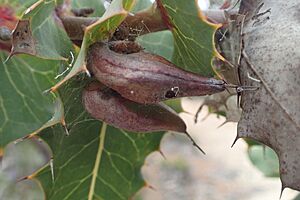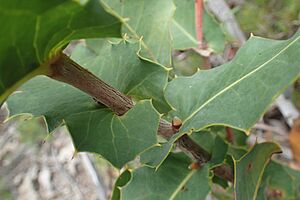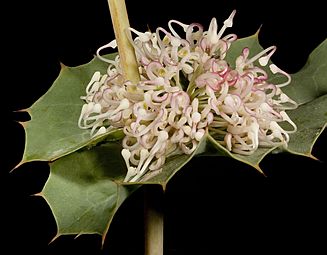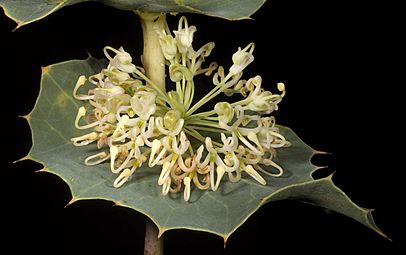Prickly hakea facts for kids
Quick facts for kids Prickly hakea |
|
|---|---|
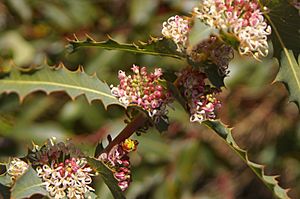 |
|
| Hakea amplexicaulis near Mundaring Weir, Western Australia | |
| Scientific classification | |
| Genus: |
Hakea
|
| Species: |
amplexicaulis
|
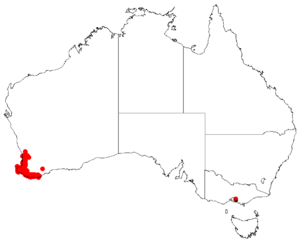 |
|
| Occurrence data from Australasian Virtual Herbarium | |
| Synonyms | |
|
Hakea amplexicaulis R.Br. var. amplexicaulis |
|
The Hakea amplexicaulis, often called prickly hakea, is a special kind of shrub. It grows naturally only in the south west of Western Australia. This means it is endemic to that area, found nowhere else in the world!
It's a beautiful small shrub with unique leaves that seem to hug its stems. These leaves have sharp, saw-like edges. In late winter and spring, it bursts with many sweet-smelling flowers that can be white, cream, pink, or even red.
Contents
What Does Prickly Hakea Look Like?
The prickly hakea is an upright shrub that can grow from about 1 to 3 meters (3 to 10 feet) tall. Its smaller branches are smooth. This plant has a special woody swelling at its base called a lignotuber. This helps it regrow after fires.
Leaves and Flowers
The leaves of the prickly hakea are shaped like a narrow egg or a full egg. They are usually 3 to 18 centimeters (1 to 7 inches) long and 20 to 65 millimeters (0.8 to 2.6 inches) wide. These leaves wrap around the stem at their base. They have 12 to 30 sharp teeth on each side, each tooth being 2 to 6 millimeters long. The leaves are smooth and have a bluish-green color with a powdery coating.
The plant produces many flowers, usually 36 to 42 of them, in rounded clusters. These flowers have a strong, pleasant smell. They grow in the spots where the leaves join the stem. The flowers can be white, cream, pink, or red. Sometimes, white flowers turn pink or reddish as they get older. Each flower has a stalk (pedicel) that is 6 to 14 millimeters long. The main part of the flower (perianth) is smooth and 4 to 6 millimeters long, often white with a hint of pink.
Fruit of the Prickly Hakea
After flowering, the prickly hakea produces egg-shaped fruits. These fruits are about 3 to 3.5 centimeters (1.2 to 1.4 inches) long and 12 to 15 millimeters (0.5 to 0.6 inches) wide. They are smooth but have a few sharp spines. The fruit tapers to a blunt, beak-like tip. Prickly hakea usually flowers from August to November.
How Prickly Hakea Got Its Name
The prickly hakea was first officially described in 1810 by a botanist named Robert Brown. He published his description in a scientific paper.
The second part of its scientific name, amplexicaulis, comes from two Latin words. Amplexus means "encircled" or "embraced," and caulis means "stem." This name perfectly describes how the leaves of this plant wrap around and seem to hug its stem.
Where Prickly Hakea Grows
You can find Hakea amplexicaulis growing in the jarrah forests of Western Australia. It stretches from the city of Perth all the way down to Albany.
This plant prefers to grow in clay, loam, and gravelly soils that are a bit acidic. It likes places that drain water well and can grow in full sun or partial shade. It's a showy shrub that provides good habitat for local wildlife and can handle a bit of frost.
Conservation Status
The Western Australian government's Department of Parks and Wildlife has classified Hakea amplexicaulis as "not threatened." This means it is not currently at risk of disappearing.
Images for kids
- Flower detail


